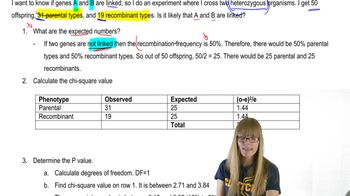Drosophila females homozygous for the third chromosomal genes pink and ebony (the same genes from Problem 16) were crossed with males homozygous for the second chromosomal gene dumpy. Because these genes are recessive, all offspring were wild type (normal). F1 females were testcrossed to triply recessive males. If we assume that the two linked genes, pink and ebony, are 20 mu apart, predict the results of this cross. If the reciprocal cross were made (F1 males—where no crossing over occurs—with triply recessive females), how would the results vary, if at all?
Table of contents
- 1. Introduction to Genetics51m
- 2. Mendel's Laws of Inheritance3h 37m
- 3. Extensions to Mendelian Inheritance2h 41m
- 4. Genetic Mapping and Linkage2h 28m
- 5. Genetics of Bacteria and Viruses1h 21m
- 6. Chromosomal Variation1h 48m
- 7. DNA and Chromosome Structure56m
- 8. DNA Replication1h 10m
- 9. Mitosis and Meiosis1h 34m
- 10. Transcription1h 0m
- 11. Translation58m
- 12. Gene Regulation in Prokaryotes1h 19m
- 13. Gene Regulation in Eukaryotes44m
- 14. Genetic Control of Development44m
- 15. Genomes and Genomics1h 50m
- 16. Transposable Elements47m
- 17. Mutation, Repair, and Recombination1h 6m
- 18. Molecular Genetic Tools19m
- 19. Cancer Genetics29m
- 20. Quantitative Genetics1h 26m
- 21. Population Genetics50m
- 22. Evolutionary Genetics29m
4. Genetic Mapping and Linkage
Mapping Genes
Problem 19b
Textbook Question
Genetic linkage mapping for a large number of families identifies 4% recombination between the genes for Rh blood type and elliptocytosis (see Problem 18). At the Rh locus, alleles R and r control Rh+ and Rh- blood types. Allele E producing elliptocytosis is dominant to the wild-type recessive allele e. Tom and Terri each have elliptocytosis, and each is . Tom's mother has elliptocytosis and is Rh- while his father is healthy and has Rh+. Terri's father is Rh+ and has elliptocytosis; Terri's mother is Rh- and is healthy.
What is the probability that a child of Tom and Terri who is Rh+ will have elliptocytosis?
 Verified step by step guidance
Verified step by step guidance1
Step 1: Understand the genetic linkage and recombination frequency. The problem states that there is 4% recombination between the Rh blood type gene and the elliptocytosis gene. This means that the two genes are linked, but there is a small chance (4%) of recombination occurring between them during meiosis.
Step 2: Analyze the inheritance patterns for Rh blood type. The Rh locus has two alleles: R (dominant, Rh+) and r (recessive, Rh-). A person with at least one R allele will be Rh+, while a person with two r alleles will be Rh-.
Step 3: Analyze the inheritance patterns for elliptocytosis. The elliptocytosis gene has two alleles: E (dominant, causing elliptocytosis) and e (recessive, wild-type). A person with at least one E allele will have elliptocytosis, while a person with two e alleles will be healthy.
Step 4: Determine the genotypes of Tom and Terri based on their parents' phenotypes. Tom's mother is Rh- and has elliptocytosis, so her genotype is rrEE or rrEe. Tom's father is Rh+ and healthy, so his genotype is RRee or Rree. Terri's father is Rh+ and has elliptocytosis, so his genotype is RREE or RREe. Terri's mother is Rh- and healthy, so her genotype is rree.
Step 5: Calculate the probability of a child being Rh+ and having elliptocytosis. Use a Punnett square to determine the possible genotypes of Tom and Terri's children, considering the linkage between the Rh and elliptocytosis genes and the 4% recombination frequency. Focus on the combinations where the child is Rh+ (has at least one R allele) and has elliptocytosis (has at least one E allele).
 Verified video answer for a similar problem:
Verified video answer for a similar problem:This video solution was recommended by our tutors as helpful for the problem above
Video duration:
3mPlay a video:
Was this helpful?
Key Concepts
Here are the essential concepts you must grasp in order to answer the question correctly.
Genetic Linkage and Recombination
Genetic linkage refers to the tendency of genes located close to each other on a chromosome to be inherited together. Recombination occurs during meiosis, where homologous chromosomes exchange genetic material, leading to new allele combinations. The percentage of recombination, such as the 4% mentioned, indicates how often genes are separated during this process, which can affect inheritance patterns.
Recommended video:
Guided course

Chi Square and Linkage
Alleles and Dominance
Alleles are different forms of a gene that can exist at a specific locus on a chromosome. In this scenario, the Rh blood type is determined by alleles R (Rh+) and r (Rh-), while elliptocytosis is controlled by the dominant allele E and the recessive allele e. Understanding dominance is crucial, as dominant alleles can mask the expression of recessive alleles in heterozygous individuals.
Recommended video:
Guided course

Variations on Dominance
Punnett Squares and Probability
Punnett squares are a tool used to predict the genotypes and phenotypes of offspring based on the genetic makeup of the parents. By analyzing the alleles contributed by Tom and Terri, one can calculate the probability of their child inheriting specific traits, such as Rh+ blood type and elliptocytosis. This method helps in understanding inheritance patterns and the likelihood of certain genetic outcomes.
Recommended video:
Guided course

Probability
Related Videos
Related Practice
Textbook Question
703
views


